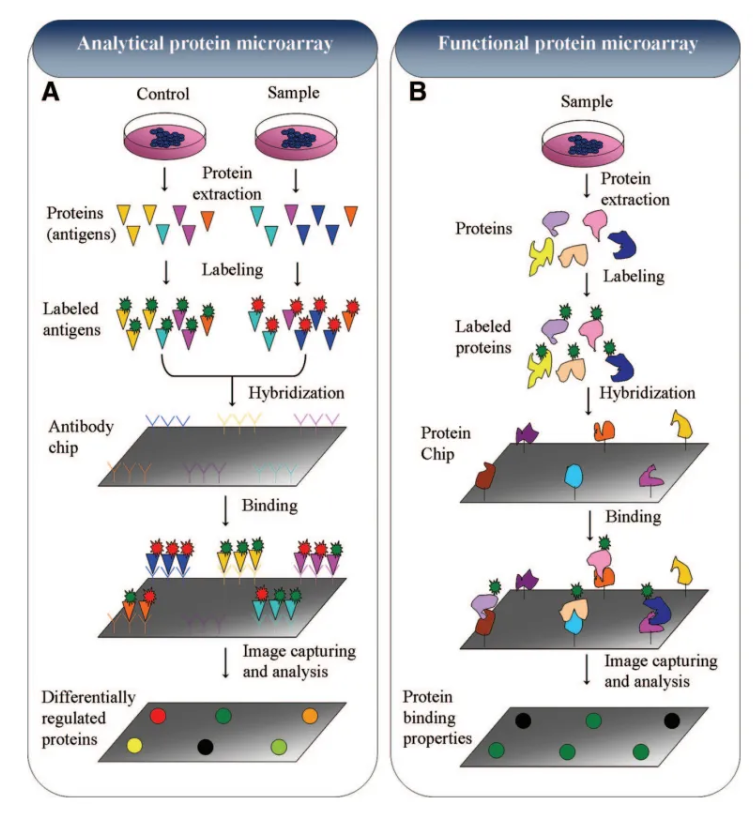Exosome Display-based Protein Array Screen Service
- Target protein or domain selection and fusion construct design
- Stable or transient expression of fusion constructs in exosome-producing cell lines
- Exosome isolation and purification
- Surface ligand validation by Western blot, ELISA, flow cytometry, or immuno-TEM
- Labeling of display exosomes (e.g., fluorescent, biotin, epitope tags)
- Incubation with custom or commercial protein microarrays
- Array scanning, signal quantification, and data analysis
- Identification of candidate interactors and functional annotation
Exosomes have become attractive vehicles for diagnostics and therapeutics due to their natural stability, biocompatibility, and capacity to reflect the molecular features of their cells of origin. In recent years, surface-engineered exosomes have gained attention not only for targeted drug delivery but also as versatile molecular display platforms. By fusing exosomal membrane proteins with exogenous peptides or protein fragments, exosomes can be tailored to present specific molecular interfaces on their surface. This forms the basis of exosome display technology, which enables targeted ligand screening, receptor binding analysis, and biomarker discovery. To leverage the full potential of this approach, MtoZ Biolabs offers a specialized Exosome Display-Based Protein Array Screen Service that identifies and validates protein–protein interactions, binding epitopes, and cell-surface targets by combining engineered exosome platforms with high-throughput array technologies.

Figure 1. Different Therapeutic Molecules can be either Loaded into Lumen or Displayed on the Exosome Surface for Clinical Purposes
Exosome display-based protein array screening is a powerful approach that integrates genetically modified exosome platforms with multiplexed protein array assays to study protein–protein or protein–ligand interactions in a physiologically relevant membrane context. In this system, exosomes are engineered to display target proteins, peptides, or domains on their surface via fusion to exosomal scaffold proteins. These display exosomes are then applied to a protein microarray composed of thousands of immobilized proteins, antibodies, receptors, or peptides. Binding events are detected via labeled tags or secondary antibodies, providing a sensitive and high-throughput method for identifying potential interaction partners, ligand candidates, or immune-reactive antigens.

Figure 2. Schematic Representation of Protein Microarray
Service at MtoZ Biolabs
MtoZ Biolabs provides a complete, customizable workflow to support exosome display and array screening projects, including:
Why Choose MtoZ Biolabs?
1. Cutting-Edge Exosome Display and Array Screening Platform
Leverages advanced molecular engineering tools and high-throughput protein microarray systems to enable sensitive and specific interaction profiling.
2. Experienced Scientific Team
Our team of exosome biology and proteomics experts provides in-depth technical support throughout construct design, assay development, and data interpretation.
3. One-Stop Customized Workflow
From ligand design and exosome engineering to labeling, array screening, and result analysis, all steps are seamlessly executed in-house to ensure consistency and efficiency.
4. Rapid and Efficient Turnaround
Optimized protocols and in-house infrastructure allow for streamlined project execution and timely delivery of high-content results.
5. High-Quality and Reproducible Data
Stringent QC at every step ensures consistent exosome quality, reliable ligand display, and robust array signals suitable for downstream validation or publication.
Applications
The Exosome Display-based Protein Array Screen Service is ideally suited for applications across biomedical research and translational development:
💠Protein–Protein Interaction Discovery: Identify novel ligands, receptors, or adhesion molecules that interact with target membrane proteins in a native vesicle context.
💠Target Validation for Therapeutics: Screen candidate binding partners for monoclonal antibodies, peptides, or biologics using native target display.
💠Antigen and Epitope Mapping: Discover immune-reactive sequences for vaccine design or immune profiling using exosome-displayed antigens on antibody arrays.
💠Tumor Microenvironment Studies: Profile the interactome of tumor-derived or immune cell-derived exosomes with stromal, vascular, or immune-associated ligands.
💠Autoimmune or Infectious Disease Research: Detect disease-associated binding signatures by screening patient-derived antibodies against exosome-presented membrane targets.
FAQ
Q: What are the advantages of the Exosome Display-based Protein Array Screen?
The Exosome Display-based Protein Array Screen offers several key advantages:
☑️Native membrane context: Fusion proteins are displayed on the surface of exosomes, preserving their natural conformation and post-translational modifications, especially for transmembrane or membrane-associated targets.
☑️High-throughput capability: Enables simultaneous screening against thousands of protein targets using array-based formats.
☑️Improved interaction fidelity: Exosome display ensures physiologically relevant binding, reducing false positives often seen in soluble or overexpressed systems.
☑️Versatile applications: Suitable for identifying protein–protein interactions, epitope mapping, receptor–ligand interactions, and biomarker discovery.
☑️Customizable design: Target peptides or proteins can be tailored and displayed based on user-defined sequences and experimental goals.
To learn how our Exosome Display-Based Protein Array Screen Service can accelerate your interaction discovery or target validation research, please contact MtoZ Biolabs. Our scientific team will work closely with you to customize your project design and provide expert guidance from start to finish.
How to order?







